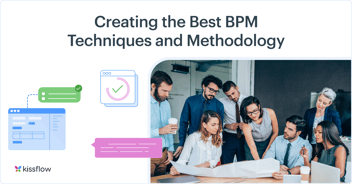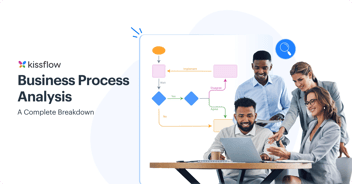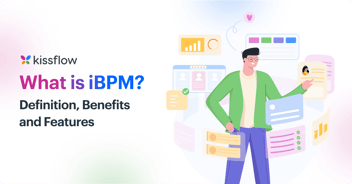
- >
- BPM Software >
- The Complete Guide to Client Onboarding Process Steps: Building Lasting Relationships in 2026
The Complete Guide to Client Onboarding Process Steps: Building Lasting Relationships in 2026
Landing a new client feels incredible. The excitement of closing a deal, the promise of revenue growth, and the validation that your services are in demand—it's a natural high. But here's what many businesses discover the hard way: the real work begins after you shake hands.
The client onboarding process steps you implement in those crucial first weeks determine whether that new client becomes a long-term partner or joins the 80 percent of customers who switch brands due to poor customer experience, according to 2024 research by Qualtrics.
What is client onboarding and why it matters more than ever
Client onboarding is the systematic process of introducing new clients to your services, setting clear expectations, and establishing the foundation for a successful working relationship. Think of it as the bridge between "yes, we want to work with you" and "this is exactly why we made the right choice."
Recent studies show that companies with a structured client onboarding workflow see:
- 82 percent higher customer retention rates after the first year
- 50 percent higher retention of new clients than those without formal onboarding
- 3x more likely to receive referrals from engaged clients
- 15-20 percent reduction in service costs through customer journey mapping
The stakes have never been higher. With 5-25x higher costs to acquire new customers versus retaining existing ones, losing clients due to poor onboarding isn't just disappointing—it's financially devastating.
The psychology behind effective onboarding new client experiences
Before diving into the tactical client onboarding process flow, let's address something crucial: your client's mental state after signing with you.
Despite choosing your services, new clients often experience what psychologists call "post-decision dissonance." They're asking themselves:
- Did I make the right choice?
- Will this company actually deliver what they promised?
- Should I have gone with their competitor instead?
Your client onboarding workflow needs to address these doubts head-on. Every interaction should reinforce their decision and build confidence in the partnership ahead. Consider that 63 percent of customers actively consider the onboarding period when deciding to subscribe to services, making first impressions absolutely critical.
The 7-step client onboarding process that drives results
Step 1: The Welcome and Expectation Setting Call
Timeline: Within 24 hours of contract signing
Don't wait. Momentum matters. Schedule a welcome call within 24 hours of contract execution. This isn't about diving into project details—it's about human connection and immediate value demonstration.
What to cover:
- Express genuine excitement about the partnership
- Confirm project timelines and key milestones
- Introduce key team members they'll work with
- Share a detailed project roadmap document
- Address any immediate questions or concerns
Pro tip: Send a personalized welcome package before this call. Include branded materials, a handwritten note from your CEO, and something that shows you understand their business. One agency sends each new client a custom coffee blend named after their company—it's memorable and demonstrates attention to detail.
Research shows that 86 percent of customers are more likely to stay loyal to businesses that provide educational and welcoming onboarding content, making this investment worthwhile.
Step 2: Deep-Dive Discovery and Goal Alignment
Timeline: Week 1
This is where many client onboarding process steps fall short. Most businesses rush through discovery, eager to start "real work." Big mistake.
Invest serious time understanding:
- Business objectives: What does success look like in 6 months? 12 months?
- Internal challenges: What obstacles have prevented them from achieving these goals?
- Stakeholder dynamics: Who are the key decision-makers and influencers?
- Communication preferences: How do they like to receive updates?
- Previous experiences: What worked (or didn't work) with past service providers?
Document everything in a shared strategy document that becomes your north star throughout the relationship.
Step 3: Contract Finalization and Legal Alignment
Timeline: Week 1-2
While lawyers and contracts might seem dry, this step protects both parties and sets professional boundaries. Your contract should be comprehensive yet clear, including:
Essential contract elements:
- Detailed scope of work and deliverables
- Payment terms and schedules
- Communication protocols and response times
- Change request procedures
- Intellectual property ownership
- Termination clauses and notice periods
- Service level agreements (SLAs) with specific metrics
Modern addition: Include data security and privacy compliance clauses. With GDPR, CCPA, and other regulations, clients expect explicit data handling protocols.
Step 4: Team Assembly and Internal Preparation
Timeline: Week 2
Your internal team needs to be as excited and informed about this client as you are. Hold a comprehensive team briefing covering:
Team preparation checklist:
- Client's business model and industry context
- Key stakeholders and their roles
- Project goals and success metrics
- Communication preferences and protocols
- Assigned single point of contact (SPOC) for different project phases
- Resource allocation and timeline commitments
Recent research shows that clients who have a dedicated SPOC report 40 percent higher satisfaction rates compared to those who interact with multiple team members without clear ownership.
Step 5: Technology Setup and Access Provisioning
Timeline: Week 2-3
The modern client onboarding workflow heavily relies on shared technology platforms. Don't underestimate this step—clunky tech experiences can derail relationships before they truly begin.
Technology setup essentials:
- Project management tool access (Asana, Monday.com, or similar)
- Communication platforms (Slack, Microsoft Teams)
- File sharing and version control systems
- Reporting and analytics dashboards
- Time tracking tools (if applicable)
- Video conferencing setup with calendar integration
Key insight: Always provide training sessions for your tools. What seems intuitive to your team might be overwhelming to clients. Record these training sessions for future reference.
Step 6: The Strategic Kickoff Meeting
Timeline: Week 3
This isn't just another meeting—it's theater. The kickoff meeting sets the tone for your entire relationship and should feel like a milestone worth celebrating.
Kickoff meeting agenda:
- Relationship introductions (15 minutes): Team members share their roles and what they're most excited about
- Project vision alignment (20 minutes): Review goals, timeline, and success metrics
- Communication framework (10 minutes): How you'll stay connected and share progress
- Quick wins preview (10 minutes): Share 2-3 early wins they can expect
- Q&A and next steps (15 minutes): Address concerns and confirm immediate action items
Pro tip: End every kickoff meeting with a clear timeline of what happens in the first 30 days. Uncertainty kills confidence.
Step 7: 30-Day Check-in and Optimization
Timeline: End of Month 1
Most businesses stop actively onboarding after the kickoff meeting. That's a mistake. The 30-day check-in is your opportunity to course-correct before small issues become big problems.
30-day review framework:
- Progress against initial milestones
- Communication effectiveness assessment
- Team dynamics and working relationship quality
- Any emerging challenges or opportunities
- Feedback collection and action planning
Modern client onboarding process flow: the technology factor
The client onboarding process flow has evolved dramatically with technology. Here's how leading service businesses are leveraging automation while maintaining personal touch:
Automated Workflow Components:
- Welcome sequence emails triggered by contract signing
- Document collection portals that guide clients through required submissions
- Progress tracking dashboards that provide real-time project visibility
- Scheduled check-in reminders to ensure consistent communication
- Feedback collection surveys at key milestones
Human-Centered Elements That Can't Be Automated:
- Strategic thinking and problem-solving
- Relationship building and trust development
- Creative ideation and innovation
- Complex communication and conflict resolution
- Emotional intelligence and empathy
The most successful client onboarding workflows blend both seamlessly.
8 advanced strategies for onboarding new client success
1. The Client Success Prediction Model
Develop an internal scoring system based on client characteristics that predict long-term success. Factors might include:
- Decision-making speed during the sales process
- Internal champion strength
- Budget alignment with project scope
- Previous experience with similar services
Use this to customize your onboarding intensity and resource allocation.
2. The 72-Hour Rule
Commit to addressing any client concern within 72 hours during the first 90 days. This isn't about solving every problem immediately—it's about acknowledging the concern and providing a clear action plan.
3. The Stakeholder Mapping Strategy
Create a visual map of all client stakeholders, including:
- Decision makers and influencers
- Project champions and potential blockers
- End users and implementers
- External partners or vendors
Update this throughout the relationship and adjust communication strategies accordingly.
4. The Early Win Framework
Identify 2-3 "quick wins" you can deliver within the first 30 days. These should be:
- Visible to key stakeholders
- Directly tied to client business objectives
- Low effort for your team but high value for the client
- Something that demonstrates your expertise and approach
5. The Feedback Loop System
Implement structured feedback collection at:
- Day 7: Initial impressions and any immediate concerns
- Day 30: Process effectiveness and team dynamics
- Day 60: Progress satisfaction and communication quality
- Day 90: Overall onboarding experience and relationship trajectory
6. The Documentation Excellence Standard
Create a shared knowledge base that includes:
- All project decisions and rationale
- Meeting notes and action items
- Resource libraries and best practices
- FAQ sections for common questions
- Process documentation and workflows
7. The Escalation Protocol
Establish clear escalation paths for different types of issues:
- Technical issues: Direct team member → Project manager → Department head
- Strategic concerns: Project manager → Account manager → Executive team
- Relationship conflicts: Account manager → Client success manager → C-level
8. The Success Celebration Strategy
Build celebration moments into your onboarding process:
- Acknowledge milestones reached
- Share positive feedback from stakeholders
- Highlight measurable progress and wins
- Recognize exceptional team member contributions
Common client onboarding mistakes that kill relationships
Mistake #1: The Information Dumping Approach
Overwhelming clients with every process, tool, and team member on day one. Instead, introduce complexity gradually and always in context of immediate relevance. Remember that 74 percent of potential customers will switch to competitors if the process is too complicated.
Mistake #2: The Set-and-Forget Mentality
Assuming that once contracts are signed and access is provided, clients will naturally integrate into your processes. Active guidance and support are essential throughout the first 90 days.
Mistake #3: The One-Size-Fits-All Process
Using identical onboarding approaches for different client types, industries, or project complexities. Customize your approach based on client characteristics and needs.
Mistake #4: The Internal Focus Trap
Optimizing processes for your team's efficiency rather than the client's experience. While internal efficiency matters, client experience should drive process design.
Mistake #5: The Communication Vacuum
Failing to proactively communicate progress, challenges, or changes. Silence breeds anxiety and doubt in new client relationships.
Measuring your client onboarding success: 2026 metrics that matter
Track these key performance indicators to optimize your client onboarding process:
Immediate Metrics (0-30 days):
- Time to first delivery: Average days from contract signing to first deliverable (74 percent of companies now have dedicated onboarding teams to manage this)
- Onboarding completion rate: Percentage of clients completing all onboarding steps
- Initial satisfaction score: Client-reported satisfaction after first month (target: 90 percent+, as 90 percent of companies believe they can improve their onboarding)
- Team introduction completion: Percentage of key stakeholder meetings completed
Short-term Metrics (30-90 days):
- First milestone achievement rate: Percentage of clients hitting initial project milestones on time
- Communication responsiveness: Average response time to client requests
- Issue resolution speed: Average time to resolve onboarding-related problems
- Stakeholder engagement level: Number of client team members actively participating
Long-term Success Indicators (90+ days):
- Client retention rate: Percentage of clients still active after 12 months (industry benchmark: 75.5 percent across all industries)
- Project expansion rate: Percentage of clients increasing scope within first year (60 percent probability of selling to existing vs 5-20 percent to new clients)
- Net Promoter Score (NPS): Client likelihood to recommend your services
- Referral generation rate: Number of referrals received from successfully onboarded clients
Industry-specific client onboarding considerations
Professional Services (Legal, Consulting, Accounting)
- Emphasize confidentiality and security protocols
- Provide clear billing and time tracking transparency
- Establish regular reporting cadences
- Create detailed compliance documentation
Digital Marketing Agencies
- Set up comprehensive analytics and reporting access
- Establish content approval workflows
- Create brand guideline documentation
- Plan campaign launch timelines with buffer periods
Software Development Teams
- Define technical requirements and constraints
- Establish development environment access
- Create user story and acceptance criteria processes
- Plan deployment and testing procedures
B2B SaaS Companies
- Focus on user adoption and feature utilization
- Create role-based access and permissions
- Develop training programs for different user types
- Establish success metrics and goal tracking
The future of client onboarding: trends shaping 2026 and beyond
Artificial Intelligence Integration
AI-powered tools are revolutionizing client onboarding through:
- Predictive analytics for identifying at-risk relationships early
- Automated workflow optimization based on client behavior patterns
- Personalized content delivery tailored to client preferences and industry
- Intelligent scheduling that optimizes meeting timing and attendee selection
Remote-First Onboarding Strategies
With distributed teams becoming permanent, onboarding must account for:
- Asynchronous communication preferences across time zones
- Digital-first document sharing and collaborative workspaces
- Virtual relationship building techniques and tools
- Cultural sensitivity for global client relationships
Data-Driven Personalization
Modern onboarding leverages data to create highly personalized experiences:
- Client journey mapping based on industry benchmarks and historical data
- Customized milestone tracking aligned with client-specific success metrics
- Adaptive communication frequency based on client engagement patterns
- Predictive content recommendations for relevant resources and training
Creating your client onboarding process documentation
Once you've refined your approach, document everything in a comprehensive onboarding playbook that includes:
Template Library:
- Welcome email sequences
- Contract templates with standard clauses
- Kickoff meeting agendas and presentation templates
- Check-in survey forms and feedback collection tools
- Project handoff documentation and checklists
Team Training Materials:
- Role-specific onboarding responsibilities
- Client communication best practices
- Escalation procedures and contact information
- Common objection handling and response scripts
- Success story examples and case studies
Client-Facing Resources:
- Process overview documents and timelines
- FAQ sections for common questions
- Video tutorials for tools and processes
- Contact directories with role clarifications
- Resource libraries organized by topic and urgency
How Kissflow streamlines your client onboarding workflow
Implementing a comprehensive client onboarding process doesn't have to be overwhelming. Kissflow's low-code workflow automation platform empowers businesses to create, customize, and optimize client onboarding workflows without extensive technical expertise.
With Kissflow, you can automate the client onboarding process from initial welcome sequences and document collection to milestone tracking and feedback gathering. The platform's intuitive drag-and-drop interface allows you to design workflows that match your specific business needs, ensuring consistent delivery of your onboarding experience across all new clients.
Key features that transform client onboarding include automated task assignments, real-time progress tracking, customizable approval workflows, and integrated communication tools that keep all stakeholders informed. Whether you're managing contract approvals, coordinating team assignments, or tracking project milestones, Kissflow eliminates the manual overhead that often derails onboarding efforts.
The platform's reporting capabilities provide the metrics visibility you need to continuously optimize your client onboarding process steps. This helps you identify bottlenecks and measure the success indicators that matter most to your business growth.
Today Try Our Kissflow Workflow Automation Platform
Ready to transform your client onboarding? Get Start Now!
Related Articles











